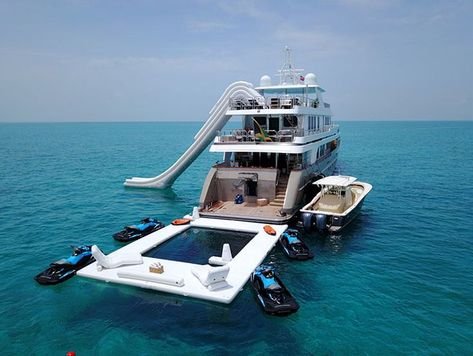Inflatable docks are revolutionizing the way we think about boat storage and access to water. Whether you’re a boating enthusiast, a fisherman, or someone who loves water sports, an inflatable dock can provide you with the flexibility and convenience you need. These portable platforms offer numerous benefits that traditional docks simply can’t match. In this comprehensive guide, we’ll explore everything you need to know about inflatable docks, from their features to installation, maintenance, and advantages.

What Is an Inflatable Dock?
An inflatable dock is a type of floating platform designed to serve as a docking area for boats, jet skis, kayaks, or other watercraft. Unlike traditional wooden or concrete docks, inflatable docks are made from durable, high-quality materials like PVC or Hypalon, and they are filled with air to create a buoyant surface.
The flexibility of inflatable docks makes them a favorite among boat owners and water sport enthusiasts. These docks are lightweight, easy to transport, and can be set up on any water body like rivers, lakes, or oceans. Their portability allows users to install them at various locations depending on their needs, making them incredibly versatile.
Types of Inflatable Docks
There are several types of inflatable docks available, and each one is suited for different purposes. Let’s take a look at some of the most common types:
1. Inflatable Boat Dock
This type of dock is specifically designed to accommodate boats. It’s a perfect solution for boat owners who need a reliable docking area without the permanence of traditional docks. Inflatable boat docks come in various sizes to suit different types of boats, from small recreational vessels to larger yachts.
2. Inflatable Floating Dock
An inflatable floating dock is a versatile platform that can support multiple watercraft simultaneously.People can use these docks as a staging area for boats, kayaks, and jet skis, or for recreational activities like sunbathing or fishing. They can easily move the docks from one location to another, making them ideal for those who want a temporary or mobile docking solution.
3. Portable Dock
A portable dock is a type of inflatable dock designed for easy transport and storage. Whether you are going to a new water location or need to store your dock during the off-season, a portable dock offers the flexibility to do so with minimal effort.
4. Inflatable Jet Ski Dock
Specifically built for jet skis, this type of inflatable dock features a compact design that keeps your watercraft secure. With its sturdy construction and buoyant material, it helps to prevent damage to your jet ski while it’s docked.
Benefits of Inflatable Docks
Inflatable docks offer several advantages over traditional wooden or concrete docks. Below are some of the key benefits:
1. Portability
One of the primary advantages of inflatable docks is their portability. These docks are lightweight and easy to move, meaning you can take them wherever you need them. Whether you’re relocating to a different dock location or just need to store it away during the off-season, portability is a game-changer.
2. Easy Installation
Setting up an inflatable dock is a breeze compared to traditional docks, which may require complex installation procedures and permits. Inflatable docks usually come with instructions for quick setup, making it a DIY-friendly project. Most inflatable docks can be inflated and set up in just a few hours.
3. Cost-Effective
Inflatable docks are generally more affordable than traditional docks. The materials used are cost-effective, and the manufacturing process is simpler. This makes inflatable docks a great choice for those looking for a budget-friendly solution without compromising on functionality.
4. Durability
Although inflatable docks are lightweight, they are made from high-strength materials that are designed to withstand harsh weather conditions, UV rays, and wear and tear from watercraft. As long as they are maintained properly, inflatable docks can last for many years.
5. Space Efficiency
Inflatable docks don’t take up as much space as traditional docks, which is ideal for areas with limited waterfront space. They can be deflated and stored when not in use, leaving more room for other activities or even other watercraft.
6. Customizability
Inflatable docks come in various sizes and designs, allowing you to choose one that best suits your needs. Whether you need a dock for one small boat or multiple watercraft, there’s an inflatable dock out there that will meet your requirements.
7. Eco-Friendly
Since inflatable docks are portable and don’t require permanent construction, they are a more eco-friendly option compared to traditional docks. There’s no need to disturb the natural environment, and they can be moved if necessary to minimize impact on marine ecosystems.
How to Choose the Right Inflatable Dock
When shopping for an inflatable dock, there are a few things you should consider to ensure you get the best product for your needs. Here’s a quick guide on what to look for:
1. Size and Weight Capacity
Choose a dock that’s the right size for your boat or watercraft. If you plan on docking multiple vessels, ensure that the inflatable dock can support their combined weight. You should also consider the size of the space where the dock will be placed to ensure it fits.
2. Material Quality
Look for docks made from durable, UV-resistant materials like PVC or Hypalon. These materials are not only strong but also resistant to wear and tear caused by exposure to the sun, saltwater, and other environmental factors.
3. Ease of Setup
Check if the dock is easy to inflate, deflate, and transport. Most inflatable docks come with pumps for easy inflation, but it’s always good to check if the process is hassle-free.
4. Dock Type
As discussed earlier, there are different types of inflatable docks suited for various needs. Make sure to choose the one that best fits your boating or water sports activities.
5. Budget
While inflatable docks tend to be more affordable than traditional docks, prices can still vary depending on the size, material, and features. Consider your budget and choose a dock that offers the best value for your money.
Maintenance and Care for Your Inflatable Dock
Although inflatable docks are low-maintenance, there are still some steps you should take to prolong their lifespan:
1. Clean Regularly
Rinse your inflatable dock with fresh water after each use to remove saltwater and debris. Regular cleaning prevents buildup, which can damage the material over time.
2. Inspect for Damage
Before and after each use, inspect your dock for any visible damage, such as tears or punctures. Promptly repair any damage to prevent further issues. Most inflatable docks come with patch kits to fix small holes.
3. Store Properly
When not in use, deflate your dock and store it in a dry, cool place away from direct sunlight. This will prevent UV damage and keep the material from degrading over time.
4. Inflate Correctly
Over-inflating or under-inflating your dock can lead to problems. Follow the manufacturer’s guidelines for inflation to ensure optimal performance.
Conclusion
Inflatable docks are changing the game for watercraft enthusiasts who want a reliable, portable, and cost-effective docking solution. Their portability, easy installation, durability, and eco-friendly nature make them a superior choice over traditional docks in many cases. Whether you’re looking for an inflatable boat dock, a floating platform for water sports, or a portable jet ski dock, inflatable docks offer flexibility and convenience that can’t be beat.
By choosing the right inflatable dock, properly maintaining it, and taking care of it with regular cleaning and inspections, you can enjoy many years of use. Whether you’re at home or on the go, an inflatable dock is a great addition to any boating setup
Explore More: Futurefinancevision





